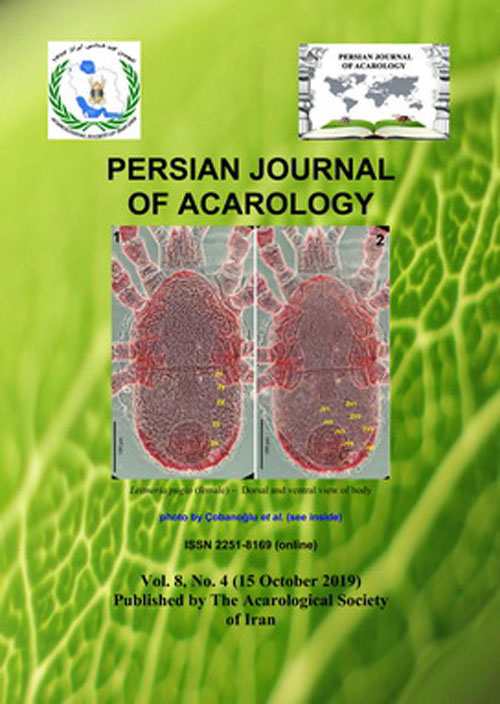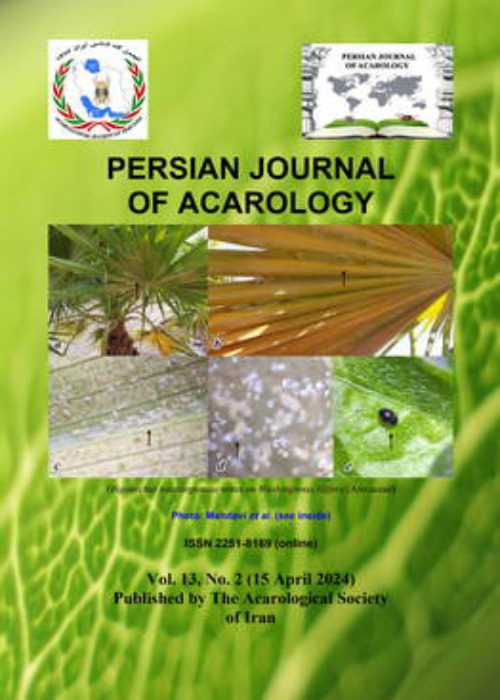فهرست مطالب

Persian Journal of Acarology
Volume:10 Issue: 2, Spring 2021
- تاریخ انتشار: 1400/02/29
- تعداد عناوین: 10
-
-
Pages 127-135
new species of galumnid mite (Acari: Oribatida: Galumnidae), Pergalumna (Pergalumna) granulistriata Akrami sp. nov., is described from soil in Zanjan Province, northwestern Iran. It is characterized by dentate rostrum; granulatestriate prodorsum; minute interlamellar setae; short bothridial setae, with finely barbed claviform head; complete dorsosejugal furrow; porose areas Aa divided into two parts, its anterior part very large, irregularly key-shaped, posterior part very small, rounded; presence of median pore; longitudinally striated genital plates and large, elongated postanal porose area. The new species is morphologically most similar to Pergalumna (P.) formicaria (Berlese, 1914), however, differs from it by the presence of teeth on rostrum; the surface ornamentation of prodorsum and pteromorphs; divided notogastral porose areas Aa. An identification key to known species of Iranian Pergalumna is given.
Keywords: Galumnid mites, morphology, Sarcoptiformes, taxonomy, Zanjan -
Pages 137-143
Leptus (Leptus) pouryayevalii sp. nov. (Acari: Erythraeidae), collected by shaking the leaves of weeds on white tray (off host) from Koushk Bala village, Chalous road, Alborz Province, Iran, is described and illustrated based on larva. This species belongs to the sudanensis species group and hospeticus species subgroup which can be identified based on the following characters: TFe I without solenidion, Ge I with two solenidia.
Keywords: Alborz Province, larva, Leptinae, Prostigmata, sudanensis species group, Trombidiformes -
Pages 145-153
In this study, five pontarachnid marine mites i.e. Litarachna communis Walter, 1925, L. duboscqi Walter, 1925, Pontarachna adriatica Morselli, 1980, P. aenariensis Mari & Morselli, 1983 and P. punctulum Philippi, 1840 are reported from Antalya and Izmir. Among them, P. aenariensis is new record for the Turkish fauna (1). Pontarachna adriatica and P. punctulum are first time recorded from Antalya (2). Deutonymph of L. communis (3) and male of L. duboscqi (4) are also for the first time reported from Turkey. Each species is illustrated and briefly described with notes and lastly showed on Turkey's map.
Keywords: Antalya, Izmir, Marine mites, Mediterranean Sea, new records, Pontarachnidae -
Pages 155-166
A compilation of halacarid mite species (Halacaridae) found associated with decapod crustaceans (Arthropoda, Crustacea, Decapoda) has been carried out based on published records. In this paper, we listed 24 species associated with crustaceans altogether. These 24 species belong to 10 genera, viz. Arhodeoporus (1 species), Astacopsiphagus (1 species), Copidognathus (11 species), Halacarellus (2 species), Limnohalacarus (1 species), Lohmannella (1 species), Porohalacarus (1 species), Porolohmannella (1 species), Soldanellonyx (2 species), Thalassarachna (3 species). Majority of the association types are probably commensals or occasional invaders in nature and only a few species are assumed to be parasitic.
Keywords: Association, commensals, decapod, halacarid mites, occasional invader -
Pages 167-189
Hypoaceus gen. nov., a new genus of the family Laelapidae Berlese, is erected and described to accommodate Hypoaceus eugenitalis (Karg) comb. nov. and Hypoaceus pycnosis (Karg) comb. nov. that have been collected from Chile and Argentina. Important morphological characters of the above-mentioned species are presented and redescribed based on the type species. Some of the important morphological characters of the new genus are as follows: setae st4 absent; genitiventral shield well expanded posterior to coxae IV with two-three pairs of setae including st5 and bears numerous pore-like structures on the surface; interior appendages of internal malae elongate and scarcely barbed; epistome with fair denticles anteriorly; supralabral process long and style like; straight spermadactyl is about of twice of movable digit length; apotele two tined; male holoventral shield bearing numerous pore-like structures on the surface. Tarsus II both in male and female bearing strong spur or spine-like setae (av1 and pv1); male with strong spur-like seta (pv1) on femur II.
Keywords: Alloparasitus, chaetotaxy, Dermanyssiae, Hypoaspis, taxonomy -
Pages 191-204
The population abundance of Tetranychus urticae Koch and its naturally occurring phytoseiid mite, Amblyseius swirskii Athias-Henriot on four strawberry cultivars (029, Fortona, Markez and Wanter star) were studied during 2017/2018 and 2018/2019 seasons. In both studied seasons, the population of T. urticae was observed from mid- October, and still recorded until the beginning of May. The peaks of infestation appeared in February or March (according to the cultivar) then declined later until the end of the study. The predatory mite (A. swirskii) initially appeared in January 2018 and 2019, while its population's peaks were observed in March on the four cultivars. In the two studied seasons, 029 cultivar was infested with the maximum numbers of T. urticae followed by Markez and Fortona cultivars, while Wanter star cultivar had the lowest infestation. In the present study, as the foliar concentrations of alkaloids and phenolic compounds increased, the cultivar infestation with T. urticae decreased. In all cultivars, a positive correlation between the populations of A. swirskii and T. urticae was observed. The present work may be considered useful to develop a successful management program of T. urticae, a serious pest of strawberry.
Keywords: Population dynamics, predatory phytoseiid mites, Rosaceae, two-spotted spider mite, Tetranychoidea -
Pages 205-221
Macrolophus pygmaeus (Rambur) is a generalist predator that naturally colonizes and commercially is used as a biological control agent of various arthropod pests of agricultural crops. Since pesticides compatibility with natural enemies is a main concern for IPM programs, the aim of the current study was to assess the lethal and sublethal side effects of two acaricides, propargite and fenpyroximate widely used to control phytophagous mites. In bioassay experiments, M. pygmaeus adult individuals were fed on the two-spotted spider mite eggs immersed in the different concentrations of both chemicals during 24 hours. Probit analysis represented that LC50 values of propargite and fenpyroximate were 3.41 and 5.74 mg (ai) L-1, respectively. Demographic analysis performed with LC30 of each acaricides using the age-stage, two-sex life table procedure. Results showed that both chemicals had significant effects on the developmental time of all stages, the total pre-oviposition period (TPOP), the adult pre-oviposition period (APOP) and females’ fecundity. Also, all main population statistics were affected by the sublethal concentrations. The intrinsic rate of increase (r) was 0.15 day-1 in the control. However, this parameter in propargite and fenpyroximate treatments declined to 0.057 and 0.083 day-1, respectively. The net reproductive rate (R0) in control, propargite and fenpyroximate treated insects was 99.96, 21.16, and 71.5 offspring/individual, respectively. Mean generation time (T) in control showed 30.08 days, whilst it was 53.17, and 51.02 days in propargite and fenpyroximate sublethal treated insects, respectively. Consequently, the results achieved in this study showed that both acaricides have potential to affect the predator, adversely. Thus, they are not suitable for IPM programs in agricultural systems where this mirid bug exists as a capable biocontrol agent.
Keywords: Bioassay, bug, IPM, life table, Tetranychus urticae -
Pages 223-230
Since ticks have been recognized as one of the most important vectors of pathogens causing serious diseases in humans, a number of studies have focused on identifying the pathogen composition as well as transmission and infection mechanisms. Although a plethora of detection methods is available today, PCR-based approach is regarded as the most sensitive and rapid. However, common challenges in molecular analyses conducted on ticks are weak amplification results because of present inhibitors, either from a mammalian bloodmeal or a male DNA in female reproductive organs. Present study aimed to evaluate which body part of an engorged tick is the most preferable as a starting material in DNA extraction for molecular detection of Borrelia burgdorferi sensu lato, causative agent of Lyme borreliosis. We analyzed 58 Ixodes ricinus ticks removed from patients in The Center for Emergency Medical Assistance of the Sarajevo Canton, Bosnia and Herzegovina. Our findings suggest using the anterior half of semiengorged and fully-engorged ticks for DNA extraction with the purpose of Borrelia detection.
Keywords: anterior half of body, Borrelia burgdorferi sensu lato, engorged ticks, Ixodes ricinus, moleculardetection


